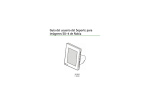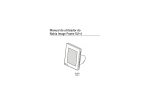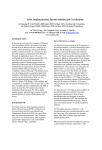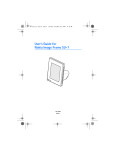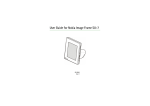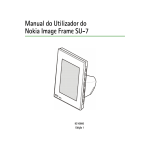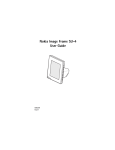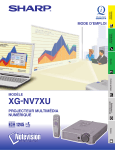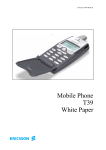Download Nokia 9300i Cell Phone User Manual
Transcript
User Guide for Nokia Image Frame SU-4 9310658 Issue 1 DECLARATION OF CONFORMITY We, NOKIA CORPORATION, declare under our sole responsibility that the product SU-4 is in conformity with the provisions of the following Council Directive: 1999/5/EC. A copy of the Declaration of Conformity can be found at http://www.nokia.com/phones/declaration_of_conformity/. Copyright © 2003 Nokia. All rights reserved. Reproduction, transfer, distribution or storage of part or all of the contents in this document in any form without the prior written permission of Nokia is prohibited. Nokia and Nokia Connecting People are trademarks or registered trademarks of Nokia Corporation. Other product and company names mentioned herein may be trademarks or tradenames of their respective owners. Nokia operates a policy of continuous development. Nokia reserves the right to make changes and improvements to any of the products described in this document without prior notice. Under no circumstances shall Nokia be responsible for any loss of data or income or any special, incidental, consequential or indirect damages howsoever caused. The contents of this document are provided "as is". Except as required by applicable law, no warranties of any kind, either express or implied, including, but not limited to, the implied warranties of merchantability and fitness for a particular purpose, are made in relation to the accuracy, reliability or contents of this document. Nokia reserves the right to revise this document or withdraw it at any time without prior notice The availability of particular products may vary by region. Please check with the Nokia dealer nearest to you. Contents Contents FOR YOUR SAFETY ................................................................................................4 Introduction...........................................................................................................5 Power supply................................................................................................................................................. 5 Technical data .............................................................................................................................................. 5 Image format ................................................................................................................................................ 6 1. Overview.............................................................................................................8 2. Getting started ................................................................................................12 Setting up the Nokia Image Frame ......................................................................................................12 Switching the power on and off ...........................................................................................................13 3. Using the Nokia Image Frame ........................................................................14 Viewing the images...................................................................................................................................14 Editing the images ....................................................................................................................................15 Switching the screensaver on and off.................................................................................................16 Modifying the display brightness..........................................................................................................16 Sending an image from the Nokia Image Frame..............................................................................16 Receiving images with the Nokia Image Frame ...............................................................................17 Care and maintenance ........................................................................................20 Copyright © 2003 Nokia. All rights reserved. 3 FOR YOUR SAFETY Read these simple guidelines. Breaking the rules may be dangerous or illegal. Further detailed information is given in this manual. QUALIFIED SERVICE Only qualified personnel may install or repair the Nokia Image Frame equipment. CONNECTING TO OTHER DEVICES When connecting to any other device, read its user's guide for detailed safety instructions. Do not connect incompatible products. BACKUP COPIES Remember to make backup copies of all important data. WATER-RESISTANCE Your Nokia Image Frame is not water-resistant. Keep it dry. IMPORTANT: Only use chargers in dry conditions. Never supply power to the device with a charger when the device or charger or their parts are damp or wet. If the device has been exposed to salt water, wipe it immediately with a cloth dampened with fresh water to avoid corrosion. The device must then be carefully wiped dry. Do not point the IR (infrared) beam at anyone's eye or allow it to interfere with other IR devices. This device is a Class 1 Laser product. Copyright © 2003 Nokia. All rights reserved. 4 Introduction Introduction The Nokia Image Frame SU-4 is an enhancement product, which enables you to view the digital images taken or received by your IrDA-enabled Nokia phone or other compatible devices. You can connect the Nokia Image Frame to the devices using its infrared (IR) port. You can place the Nokia Image Frame on a table and view the images either one-by-one or as a slide show. The Nokia Image Frame comes supplied with three pre-loaded images, and you can conveniently add new images from a compatible device and delete old images. Read this user’s guide carefully before using the Nokia Image Frame. ■ Power supply Check the model number of any charger used to supply power before use with this device. The Nokia Image Frame is intended for use with the ACP-12 charger. Warning! Use only chargers approved by the manufacturer for use with this particular enhancement. The use of any other types will invalidate any approval or warranty applying to the enhancement, and may be dangerous. For availability of approved chargers, please check with your dealer. When you disconnect the power cord of any enhancement, grasp and pull the plug, not the cord. ■ Technical data • Weight: 425g Copyright © 2003 Nokia. All rights reserved. 5 • Width (max) / height (max) / depth (max): 170 mm / 129 mm / 123.0 mm • Display: 5.1" transmissive backlit STN color LCD 320 x 240 horizontal orientation, 4096 colors. The image resolution in these materials may appear different. • Operating temperature: 0 oC to 40 oC • Compatibility: The Nokia Image Frame SU-4 is compatible with phones and other devices that support image sending over infrared (IrDA). Note that if image sending cannot be activated from the phone (IrDA Send feature), the Nokia Image Frame can pull the images from the compatible Nokia phone when the phone’s IR connection has been activated. • IrDA standards: IrOBEX 1.3 receive/send, IrTranP receive • Supported image format: JPEG and GIF (not animated GIF) • Supported image size: max 1024 * 768, up to 200 kB. Due to different techniques of image processing, even up to 1 MB. ■ Image format The Nokia Image Frame converts all the received images to JPEG format with the 320x240 pixel resolution. If the resolution of the received image differs from this resolution, the Nokia Image Frame scales the image so that it fits optimally on the display. When you send images from the Nokia Image Frame, they are sent with the JPEG format, since the Nokia Image Frame does not store the original formats of the Copyright © 2003 Nokia. All rights reserved. 6 Introduction received images. You should therefore remember to make backup copies of your original images. Copyright © 2003 Nokia. All rights reserved. 7 1. Overview The Nokia Image Frame has the following main parts: 1. Display 2. Infrared (IR) port 3. Control keys 4. Table support You can use the Nokia Image Frame through the control keys on top of the device. The control keys are: 1. Power on/off key 2. Show/Brightness key Copyright © 2003 Nokia. All rights reserved. 8 Overview 3. Rotation key 4. Three-position switch: • Slide show mode • Image view mode • Edit mode 5. Up key 6. Down key 7. Mark key 8. IrDA key There are three ways to press the keys. These are as follows: • Press briefly - press a key for less than one second • Press - press a key for at least one second • Press and hold - press and hold down the key for at least three seconds Indicators on the display This indicator shows that the image has been marked for viewing. The memory in the Nokia Image Frame is full, 50 images are stored in the Nokia Image Frame. If the memory becomes full in the middle of image transfer, the rest of the images are discarded. Copyright © 2003 Nokia. All rights reserved. 9 The Nokia Image Frame is rotating the image 90o clockwise. The Nokia Image Frame is switching to the next image. The Nokia Image Frame is switching to the previous image. Confirms that the image has been successfully deleted. This indicator blinks when the Nokia Image Frame attempts to establish the IrDA connection. When the connection is established and the Nokia Image Frame is sending or receiving an image, the indicator is displayed continuously. Confirms that the images have been successfully received or sent (the receiving device has confirmed the images as received). The image is not supported by the Nokia Image Frame. It is, for example, too large or not in the compatible format. An error occurred during the image transfer. This indicator shows how many images have been marked for viewing and how many images in total have been stored. The maximum number of stored images is 50. Copyright © 2003 Nokia. All rights reserved. 10 Overview The progress bar is shown while the Nokia Image Frame processes the received images. Copyright © 2003 Nokia. All rights reserved. 11 2. Getting started ■ Setting up the Nokia Image Frame 1. Connect the lead from the charger to the socket at the back of the Nokia Image Frame (1). 2. Connect the charger to an AC wall socket. 3. Set the Nokia Image Frame on the table with the control keys on the top. If most of your images are in the upright position, you can turn the Nokia Image Frame upright so that the control keys are on the right side of the display. You can turn the table support (2) at the back to change the angle of the Nokia Image Frame display. Copyright © 2003 Nokia. All rights reserved. 12 Getting started ■ Switching the power on and off Press to switch on the Nokia Image Frame. Press to switch off the power. Unplug the Nokia Image Frame when not in use. Copyright © 2003 Nokia. All rights reserved. 13 3. Using the Nokia Image Frame ■ Viewing the images If there is only one image in the Nokia Image Frame, it is displayed when you switch on the power. If there is more than one image in the Nokia Image Frame, you can set the Nokia Image Frame to show just one image, or several images in rotation as a slide show. Setting Nokia Image Frame to show one image: 1. Slide the three position switch to . 2. Press briefly or to scroll through the images and select the image you want to view. If you press and hold or , the images scroll automatically at 3-second intervals. You can scroll through all the marked images. For more information about marking the images, see Editing the images on page 15. Setting Nokia Image Frame to show the slide show: • Slide the three position switch to . The Nokia Image Frame displays all the marked images in rotation so that each image is shown for 30 seconds at a time. For more information about marking the images, see Editing the images on page 15. Copyright © 2003 Nokia. All rights reserved. 14 Using the Nokia Image Frame ■ Editing the images When the power is switched on and the edit mode activated, you can delete the images and mark the images you want for viewing. Deleting images: Remember to make backup copies of your images by, for example, sending and saving them to another compatible device. 1. Slide the three position switch to 2. Press briefly or want to delete. 3. Press and hold . until the Nokia Image Frame displays the image you and until the icon is displayed. Marking the images for viewing: 1. Slide the three position switch to 2. Press briefly or . to scroll the images. 3. If you want to be able to view an image, mark it by pressing briefly while the image is displayed. The Nokia Image Frame displays the all marked images. If you want to unmark an image, press briefly the marked image is displayed. icon for while When the Nokia Image Frame receives new images, it automatically marks them. If you do not want to view the new images, unmark them as explained above. Copyright © 2003 Nokia. All rights reserved. 15 Rotating images: You can rotate the images both in the edit mode and when you are viewing the images. When the image you want to rotate is displayed, press to rotate the image 90o clockwise. The Nokia Image Frame stores the orientation of the image, and the next time the Nokia Image Frame displays the image, it uses the new orientation. ■ Switching the screensaver on and off You can activate the screensaver, if you want to turn off the display without turning off the device. Press and hold to activate the screensaver. You can turn the display back on by pressing any control key. The Nokia Image Frame activates the screensaver automatically if no keys have been pressed for 18 hours. ■ Modifying the display brightness When the power is switched on, you can modify the brightness of the display by pressing briefly . There are five brightness levels, and each time you press , the level is raised by one. When the highest brightness level is used and you press , the Nokia Image Frame returns to the lowest brightness level. ■ Sending an image from the Nokia Image Frame When the power is switched on, select the image you want to send on the display of the Nokia Image Frame. Copyright © 2003 Nokia. All rights reserved. 16 Using the Nokia Image Frame 1. If needed, activate the IR port of the device to which you want to send an image. 2. Direct the IR ports of the Nokia Image Frame and the receiving compatible device toward each other, and ensure that there are no obstructions between the devices. The maximum allowed distance is up to 1.5 m and the transmission angle 15o. 3. Press and to send the image. The icon blinks while the Nokia Image Frame attempts to establish a connection to the receiving device. During the image transfer the icon stops blinking. When the image is successfully sent, the Nokia Image Frame displays the icon. ■ Receiving images with the Nokia Image Frame When the power is switched on, the Nokia Image Frame can receive images. Note that the Nokia Image Frame converts the received images to display them. For more information, see Image format on page 6. The image receiving procedure differs depending on the sending device. If the sending device can send images over IR, you can send the selected images from the device while the Nokia Image Frame is in the passive IR reception mode. If image sending cannot be activated from the sending device, the Nokia Image Frame can pull all the images from the sending device’s default image folder using the active IR reception mode. Copyright © 2003 Nokia. All rights reserved. 17 Receiving images over IR: 1. If you want the images in the Nokia Image Frame to be in a certain order, press briefly or to scroll to the image after which you want to store the new images. 2. Direct the IR ports of the Nokia Image Frame and the compatible sending device toward each other, and ensure that there are no obstructions between the devices. The maximum allowed distance is up to 1.5 m and the transmission angle 15o. 3. When the sending device starts to send the images, the Nokia Image Frame enters the passive IR reception mode and displays the icon. For more information on how to initiate sending from the other device, refer to the user’s guide of that device. 4. During the image transfer, the Nokia Image Frame displays the the received images one by one. icon and 5. After the images have been received, the Nokia Image Frame returns to the previous mode, and the images are stored as the next images after the currently displayed image. If you want to edit the new images, see Editing the images on page 15. Pulling images over IR: The Nokia Image Frame pulls all the images from the image source device’s default directory. The maximum number of images in the Nokia Image Frame is 50. If this limit is reached during the image transfer, the transfer is disconnected so that only 50 images in total are stored to the Nokia Image Frame. Copyright © 2003 Nokia. All rights reserved. 18 Using the Nokia Image Frame 1. If you want the images in the Nokia Image Frame to be in a certain order, press briefly or to scroll to the image after which you want to store the new images. 2. Direct the IR ports of the Nokia Image Frame and the compatible image source device toward each other, and ensure that there are no obstructions between the devices. The maximum allowed distance is up to 1.5 m and the transmission angle 15o. 3. Activate the image source device’s IR connection. For more information on how to do this, refer to the user’s guide of that device. 4. Press to enter the active IR reception mode. The Nokia Image Frame displays the icon. 5. During the image transfer, the Nokia Image Frame displays the the received images one by one. icon and 6. After all the images have been received, the Nokia Image Frame returns to the previous mode, and the images are stored as the next images after the currently displayed image. If you want to edit the new images, see Editing the images on page 15. Copyright © 2003 Nokia. All rights reserved. 19 Care and maintenance Your Nokia Image Frame SU-4 is a product of superior design and craftsmanship and should be treated with care. The suggestions below will help you to fulfil any warranty obligations and to enjoy this product for many years. • Keep all enhancements out of the reach of small children. • Keep the Nokia Image Frame dry. Precipitation, humidity and all types of liquids or moisture can contain minerals that will corrode electronic circuits. • Do not use or store the Nokia Image Frame in dusty, dirty areas. Its moving parts can be damaged. • Do not store the Nokia Image Frame in hot areas. High temperatures can shorten the life of electronic devices, damage batteries, and warp or melt certain plastics. • Do not store the Nokia Image Frame in cold areas. When it warms up (to its normal temperature), moisture can form inside, which may damage electronic circuit boards. • Do not attempt to open the Nokia Image Frame. Non-expert handling may damage it. • Do not drop, knock or shake the Nokia Image Frame. Rough handling can break internal circuit boards. • Do not use harsh chemicals, cleaning solvents, or strong detergents to clean the Nokia Image Frame. • Do not paint the Nokia Image Frame. Paint can clog the moving parts and prevent proper operation. If the Nokia Image Frame is not working properly, take it to your nearest qualified service facility. The personnel there will assist you and, if necessary, arrange for service. Copyright © 2003 Nokia. All rights reserved. 20 Care and maintenance For environmentally sound recycling; contact your local Nokia service point or check local regulations for correct disposal of household electronics. Copyright © 2003 Nokia. All rights reserved. 21





















